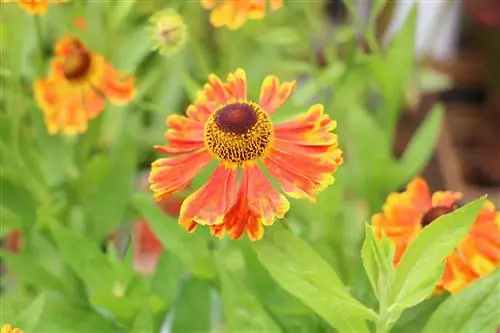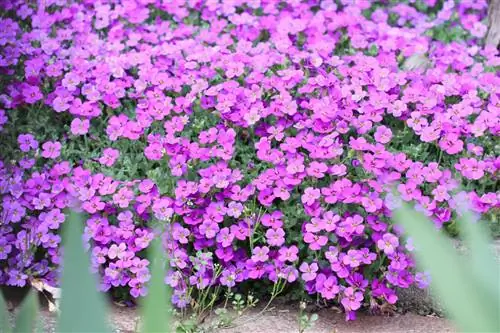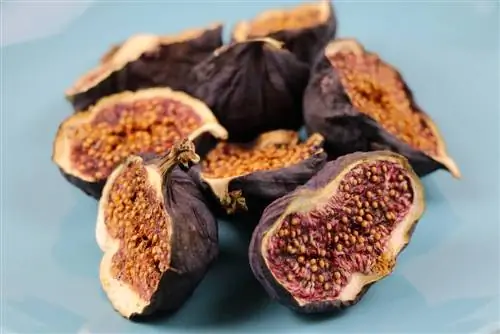- Author admin [email protected].
- Public 2023-12-17 03:39.
- Last modified 2025-06-01 06:48.
The sun bride, known by the botanical name Helenium, is a very easy-care summer perennial that belongs to the daisy family (Asteraceae). The wonderful perennial is extremely frost-resistant and has high growth vigor, and it also blooms in the most brilliant colors. The ornamental plant thrives particularly well in sunny locations and shows off its full beauty, but semi-shady places are also no problem for it. The sun bride occurs in nature in up to 40 different species! Mostly populated in North, Central and South America.
Bed and location
The sun bride, which spreads very quickly, needs as much space as possible to develop. The perennial plant particularly loves open, sunny locations in beds or large containers. That's why it's even more important to make sure that it isn't covered or shaded by other bushes, trees and plants. In addition, it is essential that the location is protected from wind and bad weather. In order to develop optimally, the Helenium needs nutritious garden soil. As soon as the ground is no longer frozen, the perennial can be planted. The following tips should be observed when planting:
- Sunny to partially shaded places
- Weather-sheltered places
- Slightly moist and nutrient-rich substrate
- Planting time: spring - autumn
- Use humus soil preferably
Watering and fertilizing
It is important to keep the sunflower's soil moist, but not wet! The most ideal way to protect the Helenium from dryness on particularly hot days is to apply mulch. The mulch ensures that the perennial is watered abundantly and thus protects it from drying out. However, it should be noted that short-term dryness is more tolerable than stagnant moisture. That's why the sun bride should only be watered when the surface of the soil has already dried out. When planting newly planted plants, it is important to ensure that they are constantly watered - ideally with a fertilizer. The following tips should be observed when watering:
- Watering regularly
- Avoiding waterlogging
- Avoiding extreme drought
- Fertilize in spring
- Monthly light fertilization
Flowers, growth and leaves
The Helenium is refreshing in pompous colors ranging from a rich orange-yellow, sparkling gold and bright red to a noble burgundy tone. There are also special hybrids in the colors: bronze, mahogany and copper. The flowers, with their spherical centers, look very similar to daisies and daisies. The styles of the sun bride are decorated with leaves on the lower part. Furthermore, the plant can grow up to 1.60 m high with appropriate care. The plant looks particularly beautiful in an autumnal garden and creates a harmonious ambience.
Tip:
To extend the flowering period, it is advisable to shorten the front part of the cane by half in May. A wooden stick to hold the perennial is also ideal.
The most important points about growth at a glance:
- Height: 50 - 160 cm
- Width: 40 - 50 cm
- Shape: Upright, bushy and clump-like
- Support tall growing species with a wooden pole
- Ideal as cut flowers
Wintering
The sun bride is a very fast-growing plant that tends to sprawl. That's why it's even more important to cut them regularly. The leaves usually stay green until the first frost. As a result, it is only sufficient to trim them if there is a lack of space. To increase the stability of the perennial, the tips should be trimmed as they shoot. However, this may only be carried out until the first buds sprout, otherwise there is a risk that the plant will suffer from the cut.
One advantage of the sun bride is that it is extremely robust. In winter, with the right protection, it can survive extremely cold days with snowfalls and freezing temperatures. To ensure successful wintering, it is important to ensure that no waterlogging occurs in the root area and that the perennial is always covered with mulch, brushwood or fleece.
Planting and propagation
Helenium is very easy and quick to grow. It is worth dividing the roots and the canes and replanting them every three years. To do this, a part of the edge of the root is cut off with a spade and replanted in any new location. An optimal time is each end and beginning of a growing season. Here, too, it is important to ensure that the sun bride stragglers are sufficiently watered! This is the only way to guarantee that they grow properly. In addition, the Helenium can also be grown with seeds - simply collect the seeds in autumn and sow them in April. The germination time is approx. 14 days.
Variety variety
The species common in Germany are largely bred, the wild varieties can mainly be admired in California. The plant, the Asteraceae genus, is related to the coneflower and the goldenrod. Small flowers and shrubs are particularly suitable as ideal neighbors in the bed.
Diseases and pests
Snails love the sun bride when the humidity is persistent. It is therefore unavoidable to constantly check the perennials for snail infestation. The perennial is also not averse to aphids. These usually jump from a neighboring plant to the Helenium. However, most pests cannot harm the steadfast plant.
Frequently asked questions
Is the Sun Bride winter-proof?
Yes, the sun bride is robust against freezing temperatures and very cold winters. However, it is important that the optimal winterization measures are taken. Ideally avoid waterlogging and cover with mulch and fleece.
What needs to be taken into account when locating the plant?
The plant particularly loves sunny places. It is also appropriate to place the Helenium next to small plants, as large plants could take away the sun.
What needs to be taken into account when watering?
The Helenium should be watered as soon as the soil above has dried out. However, the roots must not become waterlogged - this would lead to the death of the plant.
What you should know about the Sun Bride in brief
- Species/Family: Perennial. Belongs to the daisy family (Asteraceae)
- Care effort: Low. Easy to care for, robust and durable
- Flowering period: Depending on the variety, from June to October with yellow, orange, red or brown wheel-shaped, flat, daisy-like flowers with a large brown or yellow spherical center stretched upwards. There are also two-color varieties
- Foliage: Narrow, elongated, dark green leaves
- Growth: Upright, bushy, clump-like growth. Flower stalks covered with leaves at the bottom and umbel-like inflorescences at the top
- Height/width: 50 to 150cm high and 40 to 50cm wide
- Location: Sunny. Nutrient- and humus-rich, well-drained, slightly moist soil. Tolerates short-term drought better than waterlogging
- Planting time: As long as the ground is not frozen
- Cut: Autumn or winter almost close to the ground
- Partners: asters, loosestrife, phlox, golden sheaf, goldenrod, delphinium, coneflower, ornamental grasses. Different varieties combined together create a beautiful picture
- Propagation: Division in spring or take basal cuttings
- Care: Water when dry, avoid waterlogging. Stability is increased if you cut off the tips of the shoots (de-tip) as long as no buds are visible
- Wintering: Hardy. Still grateful for a cover with mulch
- Problems: Leaves and flowers wilt quickly in dry conditions
Special features
- Newly planted plants become bushier if the shoot tips are shortened in June
- Very good bee food plant
- Tall varieties should be supported
- The sun bride known to us is a breed; the wild species are often found in California
- Good cut flower
- The plants should be divided every 3-4 years to rejuvenate them
- Touch can trigger allergies in sensitive people
Species
- Autumn Sunbride - Common Sunbride (Helenium autumnale): Height 80-120cm. Blooms from August to October with approx. 3cm large basket flowers in yellow, orange or Eot
- Helenium hoopesii': height 60cm. Sunny to partially shaded. Flowers from May to July with bright yellow ray flowers and a large, spherical yellow center
Varieties (selection)
- ‘Building Director Linne’: Red-brown flowering
- 'Flower table': height 120-130cm. Blooms from August to September in bright golden yellow with a brown center
- 'Gold Lacquer Dwarf': height 70cm. Red-brown petals around a yellow center
- 'Gold Rush': height 140cm. Bright yellow flowers
- 'Kanaria': height 120cm. Yellow slightly downward curved petals with large, spherical nectar center
- 'Mahogany': height 90cm. Only blooms from August in red-brown with yellow tips on the flowers
- 'Moerheim Beauty': height 80cm. Flowering very early and profusely in red-brown-copper-red. Goes very well with diamond grass
- ‘Septembergold’: height 110cm. Late blooming variety with golden yellow flowers
- 'W altraud': Stocky growth with golden brown petals around a yellow center






